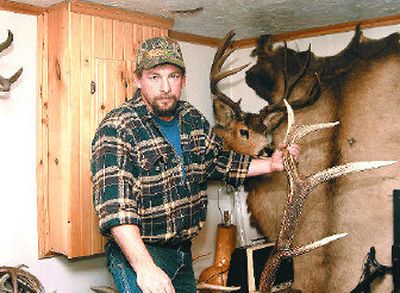Horn hunters on the lookout for ‘sheds’

It’s spring, and the woods are full of hunters – horn hunters.
These folks aren’t toting guns and wearing camouflage; instead, they’re looking for “sheds” – antlers from bull elk and buck deer that fall off in the late winter and early spring to make way for the animals to grow new sets of horns.
Rick Moe, Rose Lake-area logger, says he always is looking for shedded antlers while working.
“So far, I’ve found 11 sheds this year,” he said. One year, he found 13 deer horns in one day. Once, he found seven or eight elk antlers in one day. “More than I can carry,” he said.
This year, Moe found one elk antler weighing 14 pounds. A friend found the other shed from the same animal about a half-mile away. “It must have come off a big mature bull,” Moe said. “You don’t find that every day.”
Looking for “sheds” can be an enjoyable and profitable way to spend time in the outdoors.
“I have sold sheds in good condition for $6 to $8 a pound or $100 or more per side,” said Roy Baldwin, a forester and property assessment specialist.
But finding antlers in good condition can be challenging because many small animals like gnawing on the nutrient-rich horns.
Looking for antlers is a lot like hunting. You need to look for signs of where bucks and bulls hang out.
Obvious signs include bedding, droppings and tracks. More subtle signs include rubbings, where a bull or buck in the late fall has rubbed its antlers against saplings or small trees to help scrap off the soft, fuzzy outer coating called velvet. Later in the rut season, bulls leave their scent on trees as a territorial marker.
“I like looking for antlers where elk like to be in the spring,” Baldwin said. “Normally, on south-facing slopes where it’s nice and warm.”
Although many bulls have dropped their antlers by now, Baldwin saw a bull elk with a full head of horns grazing peacefully on his land during the first week of April.
Antlers can grow 1 inch to 1 1/2 inches a day while in the prime growth stages. A bull elk can produce 20 to 40 pounds of antler each year, with the headgear growing to 5 feet in length.
Moe collects shedded antlers to use in furniture he makes. He has built a log bar accented with antlers to hold wine bottles, and he also designs bar stools, chandeliers and coat racks as well as necklaces to sell or give away.
His secret to finding so many antlers?
“A lot of legwork.”